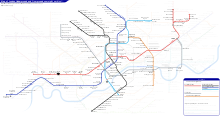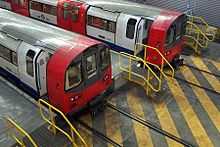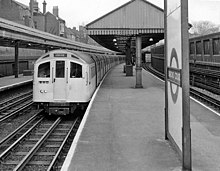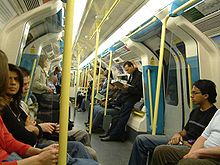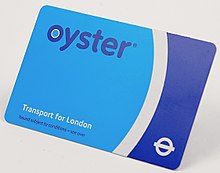London Underground
| London Underground | |
|---|---|
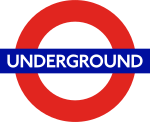
|
|

|
|
| Basic information | |
| Country |
|
| city | London |
| opening | January 10, 1863 |
| operator | London Underground Ltd. |
| owner | Transport for London |
| Employee | approx. 19,000 |
| Infrastructure | |
| Route length | 402 km |
| Gauge | 1435 mm ( standard gauge , since 1863) 2140 mm ( broad gauge , 1863–1869) |
| Power system | 630 V DC |
| Stations | 270 |
| business | |
| Lines | 11 |
| Shortest cycle | <2 minutes |
| statistics | |
| Passengers | 4.8 million per day
1,305,000,000 per year |
| website | |
| tfl.gov.uk | |
 Route map |
|
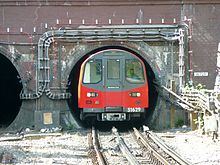
The London Underground is the oldest underground in the world and has the longest network length of any European underground. In addition to the City of London, it opens up large parts of the British capital London and some neighboring areas, especially north of the Thames .
The first section of the Metropolitan Railway (today's Metropolitan Line ) was opened on January 10, 1863 as an underground, steam locomotive operated railway . Although the world's most common name for an underground train - metro - was derived from the Metropolitan Railway , this term gave way to the term underground in British English at the end of the 19th century . In the colloquial language of Londoners, the subway is called a tube (English for "tube").
For almost 150 years the Underground was the longest underground railway in the world; it is now the third longest after the Shanghai Metro and the Beijing Subway . The route is currently 402 kilometers long with 270 stations on 11 lines, 260 of which are self-administered. Outside the city center , the majority of the lines run on the surface; in fact, only 45 percent of the route network is in the tunnel. Only the Victoria Line and the Waterloo & City Line, which has only two stations, run completely underground .
In the 2011 financial year, an average of 3.2 million passengers used the Underground every day, and up to 3.7 million on working days. During this time, a total of 1.171 billion trips were made, which was a record.
Since 2003, London Underground has been part of Transport for London (TfL), which is also responsible for the rest of the public transport system in Greater London with the exception of the railways. The legal operator is, however, the subsidiary London Underground Limited .
Line network
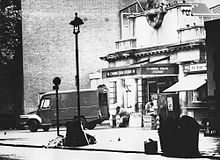
The London underground network is 402 km long, has 270 stations and consists of 11 lines, some of which have multiple branches. 14 stations are outside the boundaries of Greater London , namely three or five stations on the Metropolitan Line in the counties of Buckinghamshire and Hertfordshire and six stations on the Central Line in the county of Essex .
The trains run on weekdays, with deviations on individual lines, from around 5 a.m. (usually a little later on Saturdays) to around 1 a.m. and on Sundays from around 7 a.m. to midnight. The cycle times are two minutes at peak times, an average of four minutes during the day and up to ten minutes in the late evening. On the nights from Friday to Saturday and Saturday to Sunday there is night traffic on the Victoria Line, the Jubilee Line, parts of the Northern, Central and Piccadilly Lines as well as on the East London Line from London Overground .
The London Underground is unevenly distributed between the north and south of the city. South of the Thames is only about ten percent of the route network, the area is mainly served by suburban trains. North of the Thames it is the other way around, here the railway is limited to a few main routes to the large terminal stations.
The London lines
Closed stations and line sections
There are a number of stations on the London Underground network that are closed for various reasons. In the early days of the London Underground, escalators were completely unknown as a means of vertical transport and the lower stations, apart from emergency stairs, were only accessible by elevators . With the later installation of escalators, which also overcome a horizontal distance, the above-ground entrances have often moved closer together. It therefore seemed sensible to save some stations; others were closed due to low passenger numbers.
business
From January 2003 to May 2008 or May 2010, London Underground was partially privatized in the form of a Public Private Partnership (PPP; partnership between public authorities and private companies). The maintenance of the infrastructure was carried out by private companies, but the Underground remained in the possession of Transport for London , which was also responsible for the train operation. The goal of PPP was to develop sources of funds for future investments in the subway system. This included the construction and expansion of stations, the purchase of new rolling stock and the installation of new safety systems and train protection.
The network was divided into three groups:
- The tube sheets JNP with the lines J ubilee , N orthern and P iccadilly was obtained from Tube Lines operated
- The other tube sheets BCV (lines B akerloo , C entral and V ICTORIA ) were purchased from Metronet entertain
- The large profile lines SSL ( S UB S urface L ines) with the lines District , Metropolitan , Circle , East London and Hammersmith & City , also responsible for the Metronet was
After Metronet ran into major financial difficulties in 2007, Transport for London took over their employees and service contracts in two new subsidiaries in May 2008. In May 2010, Transport for London then acquired all of Tube Lines' shares; since then the company has been run as a subsidiary. Metronet was liquidated in 2011 .
The buyback of the London Underground Tube Lines cost £ 206.4 million. One report put the total cost of the failed PPP project to the general public at £ 5.526 billion.
Operating figures
During rush hour, the Underground currently transports 142,000 passengers an hour on the most heavily used sections. In theory, it would have a maximum capacity of 315,000 passengers per hour.
Compared to subways in other megacities, London Underground derives a relatively high proportion of its operating expenses from ticket income. In 2004, around 62 percent of the expenditure of just under £ 2 billion was financed with ticket revenues. Overall, the Underground thus had a grant requirement of 768 million pounds. In 2002, ticket sales accounted for almost 82 percent of revenue.
Employees in the bus stop
While many other underground systems no longer employ staff in the stations, all of the London Underground stations are continuously manned by several employees. The areas of responsibility include:
- support with problems at the automatic ticket barriers
- ticket sales, passenger information
- Control of train traffic in the station area, signal box
- Announcements and dispatching of trains
Special features on Christmas and New Year's Eve
On December 24th, London transport operates according to the weekday schedule.
On December 25th, there are no London public transport trains, no railways, (almost) no buses and only a few taxis, which then have a surcharge. Only replacement services between the city and Heathrow and Gatwick airports are offered.
Restrictions can also be expected on the following days (December 26th to December 30th).
On New Year's Eve (December 31st to January 1st), continuous night-time operation is offered, which can be used free of charge between 11:45 p.m. and 4:30 a.m. Lower frequency is to be expected on New Year's Eve and January 1st and 2nd.
Transport for London publishes a brochure in good time each year for the Christmas and New Years Eve.
24-hour operation (Night Tube)
From September 12, 2015, the Victoria and Jubilee Lines as well as parts of the Central, Northern and Piccadilly Lines were to be operated around the clock on the nights from Friday to Saturday and Saturday to Sunday ( Night Tube ). On most night lines provided for a 10-minute intervals, on the Northern Line even compressed to 7 1 / 2 minutes, which should bring about a reduction in travel time compared to night bus connections by an average of 20 minutes.
However, as the Underground workers demanded a wage supplement for night work, a conflict arose between the employer and the British train drivers' union. A 24-hour strike was then announced for July 8, 2015. After the unions had announced further strikes for September 2015, TfL canceled the start of the Night Tube until further notice in order to have time for further negotiations. After an agreement with the unions, the introduction of the Night Tube was announced on August 5th, 2016, and operations actually began on August 19th. In a second phase, the Night Tube was expanded with Picadilly, Central and Northern Lines on September 23, 2016. Parts of the Circle, Metropolitan, District and Hammersmith and City lines are to follow by 2021.
In the night network, tickets from the previous day are valid until 4:29 am, as the next day begins according to the tariff. In order to keep the noise pollution of residents near the underground lines as low as possible, there is cooperation with the local authorities. As a first measure, the volume of announcements was reduced. In order to guarantee the passengers safety even at night, one hundred British Transport Police forces are deployed during the operating hours of the Night Tube, as are the station staff.
This move by London Underground also moved other modes of transport to plan a night network, including the Docklands Light Railway and various railway companies.
technology

The lines of the London Underground can be divided into two types: sub-surface and tube. The subsurface railways were built like the earlier German subways in open Tunneling Method (Engl. Cut and cover ). First, an open construction pit was dug in the middle of the street. After the tunnel wall had been erected and the tracks laid, the excavation pit was closed again in sections with a cover; The road was rebuilt above the cover. The tracks are on average five meters below the surface of the earth. The tunnels are 7.62 m (25 ft.) In diameter and have the same clearance gauge as the British railways. The first section of the tunnel between Paddington and Farringdon is 7.82 m (25 ft. 8 inches) wide.
The tube tracks were initially built with a pickaxe and shovel, later using a shield drive at a depth of 20 to 50 meters. The tunnel diameter is less than half the size of the sub-surface lines, averaging 3.56 m (11 ft. 8.25 inch), each track is in a single tube. Although the standard gauge of 1435 mm is used, the clearance profile is much smaller. The two subnetworks are usually separate. The exception is the above-ground Rayners Lane - Uxbridge ; both a sub-surface line (Metropolitan Line) and a tube line (Piccadilly Line) operate here.
The lines of the London Underground are electrified with 630 volts direct current . In contrast to most other subways, two power rails are used; this is to prevent stray current corrosion in pipelines. One power rail with +420 V is located to the right or left of the running rails, depending on the local conditions, the other with −210 V between the tracks. Another advantage of this system is that the rails can only be used for signal circuits. The power rails are swept from above by the trains' pantographs . As a result, there is a risk of icing on open sections of the route. To counteract this, some vehicles are equipped with a special device that allows a de-icing fluid to be applied over the pantograph. In the open, the tracks are separated by fences to prevent accidents.
Various vehicle series from the years 1972 to 2012 are currently in use. The series of the sub-surface lines are usually identified with a letter (e.g. A Stock on the Metropolitan Line), while the series of the tube lines after are named the year they were designed (e.g. 1996 Stock on the Jubilee Line). On all lines, the trains are composed of cars from a single series. The newest series are the 2009 Stock for the Victoria Line and the S Stock for the Metropolitan, Circle, Hammersmith & City and District Lines.
history
First plans
By the middle of the 19th century, numerous railway lines were built in London, but the individual terminal stations were all outside the city center. Passengers had to travel by carriages between the individual train stations . Soon so many of them were running that the streets were hopelessly congested.
After the Great Exhibition in 1851, plans were presented for an underground broad-gauge railway. This should give the Great Western Railway the opportunity to run its trains from Paddington to the City of London . Paddington was the terminus furthest from the city and after the completion of the railway line to Birmingham the traffic situation on the access roads deteriorated considerably.
The Great Northern Railway , whose terminus King's Cross would also benefit from this route, supported the plan. An above-ground route was ruled out from the start, as it was considered sensible to separate the trains from road traffic. Aesthetic aspects also spoke in favor of an underground instead of an elevated railway .
Metropolitan Railway

On August 7, 1854 , the Metropolitan Railway (MetR) was founded. The project did not progress quickly for a number of years because the investment capital initially only flowed poorly. Finally, construction began in February 1860. After numerous delays, the first subway operated by steam locomotives was opened on January 10, 1863 . The route led from Paddington (Bishop's Road) (now Paddington ) to Farringdon Street , near today's Farringdon station . On the first day of operation, 40,000 people took the new train. This section is now served by the Hammersmith & City Line , the Circle Line and partially by the Metropolitan Line .
The route initially served mainly as an inner-city extension of the Great Western Railway (GWR). For this reason, wide-gauge tracks (2140 mm) were laid in addition to standard gauge tracks (1435 mm) . In the first few months, the Metropolitan Railway only used GWR rolling stock . Differences between the two companies led to the withdrawal of the GWR on September 30, 1863. The MetR had to rent the rolling stock from the Great Northern Railway and the London and North Western Railway for a while until their first order was delivered.
For safety reasons, smoking was prohibited on the MetR trains from the start . However, in response to popular requests from the public, in 1874 it introduced cars with smoking compartments. The MetR was also one of the first railroad companies in the country to offer particularly low tariffs for workers; For the time being, however, these only applied to a few trains. In 1880 the MetR already carried 40 million passengers a year.
After 1868, the Metropolitan Railway began to expand its network to the northwest. Harrow was reached in 1880, Rickmansworth in 1887 , Chesham in 1889 and Aylesbury in Buckinghamshire in 1892 . From Aylesbury, trains ran to Verney Junction as early as 1891 , and from 1899 to Brill, about 90 kilometers from Baker Street . Originally, the MetR wanted to establish itself as a national railway company. Express trains were to run from Baker Street to Oxford and on to the Midlands ; a dream that ultimately did not come true. The Middlesex area developed by the company was completely urbanized within a few decades and was soon nicknamed Metro-land .
Metropolitan District Railway
On July 29, 1864, a second company was founded, the Metropolitan District Railway (MDR; today District Line ). Their main task was the completion of the southern part of the inner city ring, also called Inner Circle . Their first route between South Kensington and Westminster was opened on December 24, 1868 .
The MDR also expanded into the rapidly growing suburbs. In close cooperation with other railway companies, routes to Hammersmith (1874), Richmond (1877), Ealing Broadway (1879) and Wimbledon (1889) were created. The last gap was closed on October 6, 1884 with the Mansion House - Tower of London route . Although the Circle Line was only created as an independent line in 1949, both companies drove around the entire Ring (Circle) and fought fierce competition.
First tubes and electrification
New technological developments such as shield driving made it possible to build tunnels deep below the surface. On 2. August 1870 which was Tower Subway opens, the first tube sheet ( tube ) in the world, mm with a gauge of the 762nd The stations were north of the Tower of London and in Southwark on Vine Street. A cable pulled the car through the tube, powered by two steam engines with an output of 4 hp .
The system turned out to be of little use, as the single car only offered space for 10 people. Since there was no siding, no second car could run in the tunnel. The system was expanded on December 24, 1870 and the tunnel had to be passed on foot from then on. When Tower Bridge opened in 1894, the tunnel was shut down entirely. Today the small entrance building at the tower is still preserved. The Tower Subway was not a total failure, however, as it was proven that a tunnel can also be built under the Thames.
The first electrically operated underground line, the City and South London Railway , opened on November 4, 1890 between Stockwell and King William Street at the north end of London Bridge . This route forms part of today's Northern Line . In 1898 the short Waterloo & City Line was opened between the City of London and Waterloo Station .
Between 1901 and 1908, the steam-powered lines were also largely electrified after increasing complaints from passengers: the clean electrical energy was well received and dirty steam trains in narrow tunnels were perceived as hazardous to health and antiquated. In order to be able to supply the routes with electricity, two coal-fired power stations , the Lots Road Power Station and the Neasden Power Station, were built .
expansion


At the turn of the 20th century, tunneling technology had again developed rapidly, so that four more tube lines were built within a short period of time:
- Central London Railway (opened in 1900, now Central Line)
- Great Northern, Piccadilly and Brompton Railway (opened 1906, now Piccadilly Line)
- Baker Street and Waterloo Railway (opened in 1906, now Bakerloo Line)
- Charing Cross, Euston and Hampstead Railway (opened 1907, now Northern Line)
This fragmentation of forces was inefficient. There were practically no connections between individual lines, so that passengers were forced to first go to the surface, cross a street, and then descend again. These railways were expensive to operate, and so the companies looked for financially strong investors .
One such investor was the American Charles Tyson Yerkes . His Underground Electric Railways Company of London (UERL) initially took over the financially troubled Hampstead Railway in 1900. Two years later, Yerkes controlled all other companies with the exception of the Waterloo & City Line and the Metropolitan Line . The UERL operated under the brand name Underground Group from 1902 and over time also acquired dozens of tram and bus routes . The standardization of the route network was also noticeable in the architecture: Leslie Green , Yerkes' “house architect”, built no fewer than 28 station buildings, all of which have a similar style. The course of the London Underground at greater depth and the associated access by means of large elevators explain the voluminous station buildings, which do not exist in this form in Paris, for example, where the stations are usually accessed by stairs.
In 1933 the public service company London Passenger Transport Board was created; it took over Yerkes' company, the Metropolitan Railway and all private bus and tram routes. Between the two world wars, the underground network was significantly expanded, especially the Northern Line and the Piccadilly Line. For these extensions, Charles Holden designed representative and spacious station buildings in Art Deco style, some of which are now listed . The 55 Broadway building above St. James's Park station , the headquarters of London Underground, was also made by Holden .
Second World War
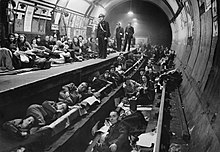
During the Second World War, and especially during the Battle of Britain , several underground underground stations served as air raid shelters . Other stations and sections of the route fulfilled other tasks:
- A newly built, but not yet opened extension of the Central Line between Redbridge and Gants Hill has been converted into an underground factory for aircraft parts for the Plessey Group; a freight railway with a gauge of 457 mm connected the individual departments with one another.
- Down Street Station, now closed, served as a meeting room for Prime Minister Winston Churchill and his cabinet for a while.
- An anti-aircraft control center was housed in the Brompton Road station, which is also closed today .
- In the Aldwych station, which has been closed since 1994 , particularly valuable art treasures of the British Museum were stored in order to protect them from destruction.
The further development
After the war, the traffic increased more and more, which led to an overload of the network. The Victoria Line opened in 1969 , the first new line in more than 60 years. It was built in such a way that there were crossings to other rail transport at all stations (except for Pimlico). It was also the first fully automatic subway in the world, the train driver only had to press a button and the train went to the next station. This technology was called Automatic Train Operation (ATO / automated driving operation ). Service trains pulled by steam locomotives ran on the Metropolitan Line until 1971 . The Piccadilly Line was extended to Heathrow Airport in 1977 .
From 1978 to 1993, Hannah Dadds (1941–2011) was the first woman to drive trains on London Underground. She did this on the District Line .
The new Jubilee Line opened in 1979 , but work on the eastern extension into Docklands was suspended for over 20 years . A route to the east via Aldwych and Ludgate Circus was actually planned . The focus was initially on above-ground rail transport, such as the Docklands Light Railway . But in 1999 the extension of the Jubilee Line was opened, albeit on a completely different route than originally planned.
In 1994 the Underground was a founding member of the subway benchmarking system Community of Metros .
The stations on the extension of the Jubilee Line set completely new standards in terms of size and expansion. So you could easily put the huge passenger ship Queen Mary 2 in the hall of the North Greenwich station , or even 3000 double-decker buses .
Since the opening of Heathrow Terminal 5 on March 27, 2008, London Heathrow Airport has been served by three stations.
Future plans, "Tube Upgrade Plan"

The UK government has pledged a total of £ 16 billion to invest by 2030. She set the following priorities: reducing delays, installing new elevators and escalators , more cleanliness and safety and a new station at the new Wembley Stadium . The capacity of individual lines is increased; in future, for example, 34 trains per hour will run on the Victoria Line instead of 28.
Expansion of the route network
- Extension of the East London Line
Shoreditch Station to the north was closed; the line was extended over the old Broad Street Viaduct and Dalston to Highbury & Islington (connection to the Victoria Line). In the south, three branches to Clapham Junction , Crystal Palace and West Croydon were realized. In order to prepare the already existing part of the East London Line for railway operations, it was closed for 18 months from the end of 2007 / beginning of 2008. Since 2010 the East London Line no longer belongs to the underground network, but to a S-Bahn-like system called London Overground .

- Relocation of the Watford branch
Together with the Hertfordshire County Council , Transport for London planned the relocation of the Watford branch of the Metropolitan Line . The existing terminus is a bit out of the way; the line should be led over a new viaduct to be built and a railway line , which had been closed since 1996, to Watford Junction , the more important station of Watford. Commissioning was scheduled for 2018, but the project was stopped for the time being due to financial difficulties.
- Reactivation of the Bakerloo Line to Watford Junction
The Bakerloo Line originally ran as far as Watford Junction , but since 1982 Harrow and Wealdstone has been the northern terminus. In November 2007, Transport for London took over the operating license of the Silverlink railway company . It is planned that the Bakerloo Line operations will be expanded back to Watford Junction. Therefore, the 1967 Tube Stock from Victoria Line are needed to complement the 1972 Tube Stock fleet, which is identical in construction. The Watford DC Line, which is part of the overground system , will then cease operations.
- Extension of the Northern Line to Battersea
The Charing Cross branch of the Northern Line is currently being extended by two stations to the former Battersea Power Station. From the Kennington stop, where the trains end today, the line to Battersea with the intermediate stop Nine Elms will be built. A total of five new trains are needed for this. However, it is planned to increase the frequency on the Northern Line and Jubilee Line , in order to save costs, these trains will be ordered in a large order with a total of 68 trains. Construction began in 2017, and the extension is to go into operation as early as 2020, as it is intended to support the large-scale development on the south bank of the Thames in Nine Elms. Another extension to the important South London railway junction, Clapham Junction, is being examined.
Accidents and disasters
Accidents involving trains
The London Underground is considered a very safe means of transport. Accidents are very rare: since London Underground was founded in 1933 there have been 61 fatal accidents. On May 17, 1938, six people died when a Circle Line train crashed into a District Line train after ignoring a stop signal at Temple Station . On April 8, 1953, a Central Line train between Stratford and Leyton collided with a parked train; twelve people died.
By far the most serious accident occurred on February 28, 1975 in the Moorgate underground accident , when a train of the Northern City Line (which was part of the Underground from 1913 to 1975 ) in the Moorgate tunnel and terminal station at a speed of over 50 km / h hit the wall at the end of the tunnel. 43 people were killed and 74 injured, some seriously.
On January 25, 2003, a Central Line train derailed at Chancery Lane station after a railcar became detached from the rest of the train; 32 passengers were injured. The entire Central Line was closed to look for the causes and make necessary adjustments to the trains. At the end of March, a limited number of trains ran again on the eastern and western outer routes. On April 3, the central section was also reopened; It was not until the end of April that the trains ran back to the normal schedule. The closure also briefly affected the Waterloo & City Line , where the same type of vehicle (1992 Tube Stock) is used.
Accidents in stations
A fire on November 23, 1984 in Oxford Circus station went smoothly and resulted in no deaths. As a result, a total smoking ban was imposed. Failure to comply with this ban led to a fire on November 18, 1987 at King's Cross St. Pancras station . A discarded match ignited a mixture of grease and dirt under an escalator. The fire set the escalator on fire and the distribution level above was enveloped in thick smoke. 31 people could not get to safety in time and suffocated. After a thorough investigation into the incident, all wooden escalators were replaced and sprinkler systems and fire alarms were installed. Since then, all station personnel at London Underground have had to complete a mandatory safety course twice a year.
Second World War
During the Second World War (especially during the Battle of Britain ), many underground underground stations were used as air raid shelters . But even these facilities did not always offer protection from the German Air Force . On March 3, 1943, 173 people were killed in Bethnal Green station . This was due to a completed but not yet opened section of the Central Line . During an air raid, a secret anti-aircraft missile was detonated in a park near the station. The unfamiliar explosion caused a panic and many people fled to the nearby station. A woman stumbled on the narrow stairs and started a chain reaction that involved 300 other people. 172 were trampled to death within seconds, and one person died a little later in hospital from the injuries.
Many people were also killed by direct bomb hits. The highest number of victims were on October 14, 1940 at Balham Station (68), on November 12, 1940 at Sloane Square Station (79) and on January 11, 1941 at Bank Station (56).
Incidents related to the July 7, 2005 attacks
On the morning of July 7, 2005, a terrorist attack in the subway network resulted in several explosions, leaving at least 700 injured and over 50 dead.
suicide
Suicide attempts are common on the underground network (once a week on average), of which one in three is fatal. The delays caused thereby are in the loudspeaker announcements as incident , passenger action ( "passenger incident") or under person a train ( "person under a train") circumscribed, (but also in some announcements) the staff but they are as under one ( " one below "). In order to increase safety and avoid suicides, the stations of the extended Jubilee Line , which opened in 1999, are equipped with glass walls on the platform edge. The walls are equipped with platform screen doors that open and close together with the car doors of the trains behind them.
Action in the event of an incident
Incidents frequently occur on the London Underground, for example with unattended or forgotten luggage, suicide attempts or fire; these are announced in all stations of the London Underground (and also in all stations of the National Rail ) by the previously recorded announcement: Due to a reported emergency all passengers must leave the station immediately. Please obey the instructions of the staff. ("Because of a reported emergency, all passengers must leave the station immediately. Please follow the instructions of the staff.") This is followed by an alarm tone.
The logo
The well-known logo of the London Underground, a red circular ring with a blue bar horizontally above it, was designed by Harold Stabler in 1908 (the Metropolitan Railway, however, had the "Diamond and Bar" logo, a diamond-shaped logo with bars). In 1916, Edward Johnston redesigned the logo on behalf of the London Passenger Transport Board. It can be seen in every station, but also in and on the individual trains, buses, trams and on the timetables. It is either attached to signs in the stations or, in some cases, even incorporated into the wall of the tunnel tubes using mosaic technology. Either the station name or the word "Underground" is shown in capital letters on the blue bar.
Johnston developed the sans-serif font Johnston Typeface , which was used for the logo from 1916; the font formed the basis for the Gill Sans developed by Eric Gill in the 1920s . The font used today is a revised version that is sold under the name "P22 Johnston Underground" by the font manufacturer P22 type foundry . Over time, the logo developed into a distinctive distinguishing feature for the underground and London itself, as did the slogan "mind the gap" (see below). These two characteristics are combined on numerous fan merchandise, which, like many historical posters and the underground network map , are marketed by the London Transport Museum .
Transport for London is known for preventing unauthorized use such as B. has the copying of the logo prosecuted. Nevertheless, numerous copies are made around the world, as the logo is very popular with London fans.
On the 50th birthday of the Berlin subway , the London Transport Executive , the then operator of the London subway, gave the Berliner Verkehrsbetriebe (BVG) a London subway sign as a token of solidarity. The BVG selected the Wittenbergplatz underground station as the location for the installation, one of the stations with the highest number of passengers in the center of West Berlin .
Line network plan

In 1933, Harry Beck , an employee of London Transport , designed a schematic route map . Beck had come to the conclusion that the passenger does not need to know the exact geographical position in order to get from one station to another, because the subway often runs underground. Only the topology , i.e. the spatial relationship between the stations, is decisive.
He began to design a line network map that resembled electrical circuit diagrams . Beck refined his design ; the plan consisted only of the labeled stations and straight lines that run either horizontally, vertically or at a diagonal 45-degree angle. London Transport initially reacted skeptically to the plan and viewed it merely as a leisure job for a simple employee. Nevertheless, as a trial, the plan was printed in a small edition and distributed to the passengers. It immediately became a huge success and is still used today, whether as a poster- sized card or a handy travel companion.
The design is now a symbol of London par excellence: it is printed on T-shirts, postcards, mugs and other souvenirs . The English artist Simon Patterson replaced the names of the stations with names of scientists, philosophers, saints or other celebrities in his work The Great Bear from 1992. The picture is on display at the Tate Modern .
Various changes have been made to the original design over the years. In particular, the problem of showing transfer options to above-ground railway lines could never be solved to Beck's satisfaction. In addition, different colors are used today for individual lines. Extensions to the network (for example the Jubilee Line ) have always been cleverly integrated; in this way, new editions were always based on the original.
Beck's design has long been used in a similar form by many other transport companies around the world, for example in Berlin , Paris or Tokyo . This concept is also suitable for light rail vehicles. A facsimile of the original 1933 plan is on display at Finchley Central Station , where Henry Beck once lived.
Also shown on the network plan are the lines of the Docklands Light Railway , a fully automatic light rail in the former Docklands port area , in the form of two thin blue-green parallel lines, the Overground lines (two thin orange parallel lines) and, since 2012, a cable car that runs from the Docklands across the Thames to North Greenwich (three thin red parallel lines).
Mind the gap
The announcement Mind the gap (literally: think about the gap ) is an announcement in the underground that has made it very well known and is in part perceived as just as typical for London as the double-decker buses. The souvenir industry now offers numerous accessories (T-shirts, mugs, bags and also underwear) with prints. The announcement served as inspiration for the German techno band Scooter for an album of the same name .
The announcement had its origin at the Embankment station of the Northern Line . Because the tunnel exactly follows the course of the road above, this station is in a curve and the gap between the car and the platform is extraordinarily wide. The announcement reminds passengers to pay attention where they are stepping. Other lines with large distances between the car and the platform are the Bakerloo Line and the Central Line .
The announcement itself is recorded and spoken by professional speakers. The first, very striking recording was made by Peter Lodge and was recorded - already digitally - in the 1960s. This announcement is kept in a harsh tone to make it unlikely that you will miss it. In addition, the edge of the platform is clearly labeled “Mind the Gap”. Since 2003 this announcement has been gradually replaced by a different version. This is spoken by Emma Clarke, a then 36-year-old freelance voice actress, and is kept in a gentler, less strict tone.
Tariff system
To calculate fares, London Underground uses the Transport for London Travelcard tariff zone system , which corresponds to a transport association . Around the central zone 1, which is largely bounded by the circle line , there are five more concentric zones. These cover the entire area of Greater London and a small part of south west Essex ; and the Heathrow Airport is one of them. Individual stations of the Metropolitan Line in Hertfordshire are outside the actual Travelcard area; Zones 7 to 9 only apply to the Underground, but not to other means of transport. In general, the more zones you drive through, the higher the fare. Tickets and season tickets that cover Zone 1 are usually more expensive than those that cover only outer zones.
In January 2006 the tariff structure for single tickets was greatly simplified. All journeys through one to four zones cost a flat £ 3 regardless of the length of the journey. Driving through five or six zones was a flat £ 4. In 2007, single tickets were made more expensive: each journey now costs £ 4. The prices for paper tickets were intentionally set so high: Passengers should be encouraged to switch to Travelcard subscriptions or to the Oyster Card .
Oyster
The Oyster Card is a blue plastic card that is equipped with an RFID chip for contactless reading.
There are several possible uses:
- Travelcard (as a season ticket from 1 week valid for certain tariff zones)
- Pay-as-you-go: the amount is debited after completing a trip.
The pay-as-you-go variant brings passengers considerable savings compared to conventional, printed tickets. With Pay-as-you-go there is a cost cap per day ( daily capping ) and tariff zone. As soon as you reach the cap with your trips, further trips (within the tariff zones whose cap you have reached) cost nothing. The aim is to encourage passengers to use the wireless Oyster card (just hold the card on the scanner). The main aim of this is to shorten the long queues at the ticket offices and reduce personnel costs.
You can top up the Oyster Card either at the ticket machines at the underground stations or at the Oyster Ticket Stops.
Travelcard
A so-called Travelcard can be purchased from the multilingual machines in the stations . They are available in different versions: The Travelcard for seven days or longer and the Day Travelcard , with which you can travel as often as you like within London for a day within the selected tariff zones - including city buses; further discounts for children or students are possible.
Contactless
Under the term Contactless , TfL offers the option of paying with NFC credit or debit cards as an alternative to the Oyster Card . As a user, you hold the card (similar to the Oyster card) to the reader when entering and exiting the subway. The costs incurred are collected and deducted en bloc from the credit card. For payments with wireless credit cards, the same cost cap (daily capping) applies as for pay-as-you-go with the Oyster card. There is also a weekly cost cap that works like daily capping (this is not possible with the Oyster Card). Alternatively, the system also works with mobile payment methods such as Google Pay or Apple Pay.
Accessibility
Since most of the London Underground stations are many decades old, they were not built according to the standards of barrier-free construction . Most stations have not been retrofitted in many areas to this day. However, extensive construction work in the tube network has been announced, in the course of which several stations will be retrofitted with lifts and new cars with more wheelchair spaces will be purchased.
This means that the majority of all stations are not accessible to people in wheelchairs . At all stations there is a corresponding passage in the barrier system for ticket control , but in most cases it is not possible to reach the platform because no elevators are available. Out of a total of 275 stations, only 40 are equipped with lifts, although in some cases these can only be used after registration. In addition, some of them cannot be reached directly, but only via a few steps from the platform.

Even when changing between individual lines, steps often have to be overcome. Only between Westminster and Stratford , the newest section of the Jubilee Line , are all stations wheelchair accessible, which is also only given at a few stations in the city center. An additional problem is the difference in height between the platform and the train. Furthermore, many trains do not have any parking spaces.
To help visually impaired and blind people, all platform edges are provided with a floor covering that differs from that of the platform. Loudspeaker announcements on the trains announce the terminus and the next stop. For these people, getting into the car is an obstacle and a safety risk. There are no aids to navigate through the often labyrinth-like stations. The only help for the hearing impaired are electronic displays in newer trains that provide information about the destination and the next station.
"GLAD" (Greater London Action on Disability), an initiative by disabled people, is committed to redesigning the London Underground. The aim is to make the use of the tube easy for all people with disabilities. According to GLAD, the tube is the least accessible form of public transport in London.
See also
literature
- Tobias Döring: London Underground . Reclam, Stuttgart 2003, ISBN 3-15-009104-7
- Keith Lowe: All along the line . Heyne, Munich 2003, ISBN 3-453-86443-3
- Bernhard Strowitzki: London Underground . GVE, Berlin 1994, ISBN 3-89218-021-0
- John R. Day, John Reed: The Story of London's Underground . Capital Transport, Harrow Weald 8 2001 (English), ISBN 1-85414-245-3
- Ludwig Troske : The London Underground . Springer, Berlin 1892 (!), VDI-Verlag, Düsseldorf 1986 (repr.). ISBN 3-18-400724-3
Web links
- Transport for London website to Tube
- London Underground at urbanrail.net
- Unused stations on the London Underground
- Development of the route network of the London Underground
- Early documents and newspaper articles on the London Underground in the 20th century press kit of the ZBW - Leibniz Information Center for Economics .
Individual evidence
- ^ London Underground - Key facts . Transport for London website, accessed June 17, 2012
- ^ Shanghai Now the World's Longest Metro . In: Railway Gazette International , May 4, 2010. Retrieved February 26, 2011
- ↑ All aboard . In: Global Times online, December 17, 2012. Retrieved January 5, 2013
- ↑ 2011 annual entries and exits. ( MS Excel ; 200 kB) TfL , archived from the original ; accessed on September 3, 2018 (values adjusted with factor so that the sum of Entry & Exit corresponds to the data in the Performance Data Almanac.).
- ↑ a b London Underground - Facts and Figures . Transport for London website (Facts & Figures), accessed November 3, 2015
- ↑ http://www.tfl.gov.uk/assets/downloads/4_Managing_Directors_Report.pdf
- ^ Transport for London: First & last Tube. Retrieved June 14, 2019 .
- ^ Party on, London ... Tube will run an hour later on Fridays and Saturdays. In: Evening Standard. January 30, 2013, accessed on April 20, 2016 (English): "Under the new plans, the first morning trains at the weekend would start at 6am on Saturday and 7am on Sunday as usual."
- ↑ a b Passenger numbers for Circle and Hammersmith & City Line calculated together
- ↑ European Services Strategy Unit Research Report No. 6: PPP Wealth Machine ( page no longer available , search in web archives ) Info: The link was automatically marked as defective. Please check the link according to the instructions and then remove this notice. (PDF; 1.8 MB), Appendix 4: Terminated UK PPP projects
- ^ Minutes of Question Time House of Commons, May 13, 2002
- ↑ Transport for London: Annual Report 2003/04 ( Memento from February 22, 2010 on WebCite ) (pdf; 1.2 MB)
- ↑ Christmas and New Year Services. Retrieved December 20, 2011
- ↑ http://www.tfl.gov.uk/campaign/tube-improvements/the-future-of-the-tube/night-tube?intcmp=22069 [accessed on: January 2, 2015]
- ↑ LU decides to defer launch of Night Tube to allow successful conclusion of union talks. In: press release. TfL, August 27, 2015, accessed September 3, 2015 .
- ↑ Night Tube will start running on August 5, Evening Standard, accessed on March 14, 2016, 8:20 pm
- ↑ release of tfl for Night Tube
- ↑ Night Tube: London publishes a nighttime timetable for the underground , article on www.spiegel-online.de
- ↑ “Dadds worked as a driver with the London Underground until she took early retirement in 1993, after which she moved to Spain. ... In 2004, she attended a Queen's Women of Achievement lunch at Buckingham Palace ; other invitees included Margaret Thatcher , JK Rowling , Kate Moss and Charlotte Church . ” History-making Hannah Dadds from Forest Gate dies. Obituary in Newham Recorder December 14, 2011
- ↑ Information on the official website ( Memento of the original dated November 2, 2010 in the Internet Archive ) Info: The archive link was inserted automatically and has not yet been checked. Please check the original and archive link according to the instructions and then remove this notice. , accessed March 19, 2016
- ^ Transport for London | Every Journey Matters: Northern line extension. Retrieved October 30, 2017 (English).
- ↑ London's subway route plan - caution, map , in NZZ, January 30, 2013
- ↑ "Mind the gap" voice is over , SpiegelOnline.de of November 26, 2007
- ↑ What is Oyster? (Transport for London)
- ↑ https://tfl.gov.uk/fares-and-payments/oyster/using-oyster/price-capping



